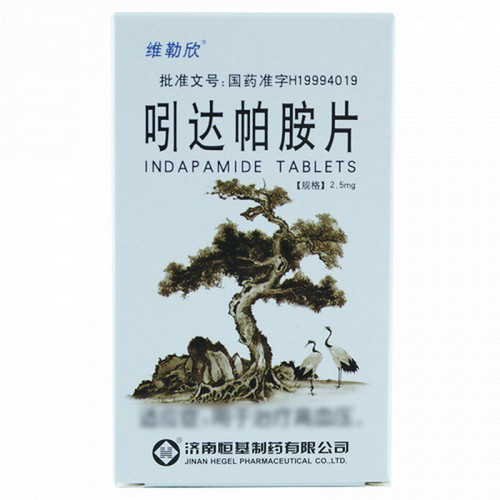Product Overview
[Drug Name]
Generic Name: Indapamide Tablets (Film-Coated)
Trade Name: Hongfei Indapamide Tablets (Film-Coated) 2.5mg*10 Tablets*3 Packs
Pinyin Code: HongFei ZuoDaPaAnPian (BaoMoYiPian) 2.5mg*10 Tablets*3 Packs
[Main Ingredient]
Indapamide.
[Properties]
This product is a film-coated tablet. After removing the film coating, it appears white.
[Indications/Main Functions]
For the treatment of essential hypertension.
[Precautions]
1. To reduce the possibility of electrolyte imbalance, a smaller effective dose is recommended. Regular monitoring of serum potassium, sodium, and uric acid levels is recommended to maintain fluid and electrolyte balance, and potassium supplementation is recommended. 2. When used as a diuretic, it is best to administer the drug once daily in the morning to avoid having to urinate during the night. 3. Anuria or severe renal insufficiency may induce azotemia. 4. In patients with diabetes, glucose tolerance may be impaired. 5. Gout or hyperuricemia: serum uric acid levels may increase further. 6. Liver dysfunction: diuresis may precipitate hepatic coma. 7. Post-sympathectomy: the antihypertensive effect may be enhanced. 8. If surgery is required while using this drug, it is not necessary to discontinue use, but the anesthesiologist must be informed.
[Drug Interactions]
Sulfonamide allergy, severe renal insufficiency, hepatic encephalopathy or severe liver insufficiency, hypokalemia.
[Pediatric Use]
Unclear information available.
[Elderly Use]
Elderly individuals are more sensitive to antihypertensive effects and electrolyte changes and often experience changes in renal function; caution is advised when using this drug.
[Pregnant and Lactating Women]
Human studies are lacking regarding its effects on pregnancy, but animal studies have not revealed any issues. Whether this drug is excreted into breast milk is unknown, but no issues have occurred in humans.
[Specifications]
2.5mg*30 tablets (Feihong)
[Dosage and Administration]
Usual adult dose: Oral, one tablet once daily.
[Adverse Reactions]
Mild, transient, and dose-related. 1. Less common: diarrhea, headache, decreased appetite, insomnia, nausea, and orthostatic hypotension. 2. Less common: allergic reactions such as rash and pruritus; hyponatremia, hypokalemia, and hypochloremic alkalosis.
[Contraindications]
Sulfonamide hypersensitivity, severe renal insufficiency, hepatic encephalopathy or severe hepatic insufficiency, and hypokalemia.
[Overdose]
No toxic effects have been observed at doses up to 40mg, 16 times the therapeutic dose. The primary symptom of acute poisoning is fluid and electrolyte imbalance (hypotension and hypokalemia). Possible clinical symptoms include nausea, vomiting, hypotension, cramps, drowsiness, confusion, and polyuria, oliguria, or even anuria (due to hypovolemia). The first step is to rapidly eliminate the ingested drug, which can be achieved through gastric lavage and/or administration of activated charcoal. Water and electrolyte imbalances should then be corrected in a specialized center until normal.
[Pharmacology and Toxicology]
This is a sulfonamide diuretic that works by inhibiting water and electrolyte reabsorption in the dilute segment of the distal renal tubular cortex. Its antihypertensive effect is unclear, and its diuretic effect cannot explain this effect, as the dose at which it occurs is much lower than the dose at which it would have a diuretic effect. Possible mechanisms include: regulating calcium influx into vascular smooth muscle cells; stimulating the synthesis of prostaglandins PGE2 and PGI2; and reducing vascular hypersensitivity to vasopressors, thereby inhibiting vasoconstriction. This drug has little or no effect on cardiac output, heart rate, and rhythm when used to lower blood pressure. Long-term use rarely affects glomerular filtration rate or renal blood flow. It does not affect lipid or carbohydrate metabolism.
[Pharmacokinetics]
Oral absorption is rapid and complete, with a bioavailability of 93%, unaffected by food. The plasma binding rate is 71-79%, and it also binds to elastin in vascular smooth muscle. Peak plasma concentrations are reached 1-2 hours after oral administration. Peak antihypertensive effect is achieved approximately 24 hours after a single oral dose; after repeated dosing, peak effect is achieved approximately 8-12 weeks later, with effects lasting for 8 weeks. The half-life is 14-18 hours. It is metabolized in the liver, producing 19 metabolites. Approximately 70% is excreted via the kidneys, 7% unchanged and 23% via the gastrointestinal tract. Pharmacokinetic parameters are not altered in patients with renal failure.








